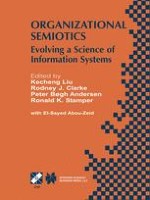2002 | OriginalPaper | Buchkapitel
Translation, Betrayal and Ambiguity in IS Development
verfasst von : Jim Underwood
Erschienen in: Organizational Semiotics
Verlag: Springer US
Enthalten in: Professional Book Archive
Aktivieren Sie unsere intelligente Suche, um passende Fachinhalte oder Patente zu finden.
Wählen Sie Textabschnitte aus um mit Künstlicher Intelligenz passenden Patente zu finden. powered by
Markieren Sie Textabschnitte, um KI-gestützt weitere passende Inhalte zu finden. powered by
This paper uses semiotic theories to model how meaning is constructed during an IS development project. Conventionally, shared meanings among all project stakeholders are regarded as a prerequisite for success. Based on an analysis of documents relating to a flexible learning pilot project developed at an Australian university, a model of meaning was built combining actor-network theory and Foucault’s theory of discourse. Important scripts were identified from internal working documents and their meaning discussed with a variety of human actors. Scripts within the actor network were interpreted with reference to expert discourses familiar to the various actors. Further analysis using this model shows how mistranslation can occur in at least two distinct ways as scripts pass between actors; through apparent acceptance of espoused scripts and the pragmatic betrayal of scripts-in-use. In our case study project these two types of mistranslation were used to maintain ambiguity over certain key issues throughout the life of the project, and this ambiguity contributed significantly to project’s success.
